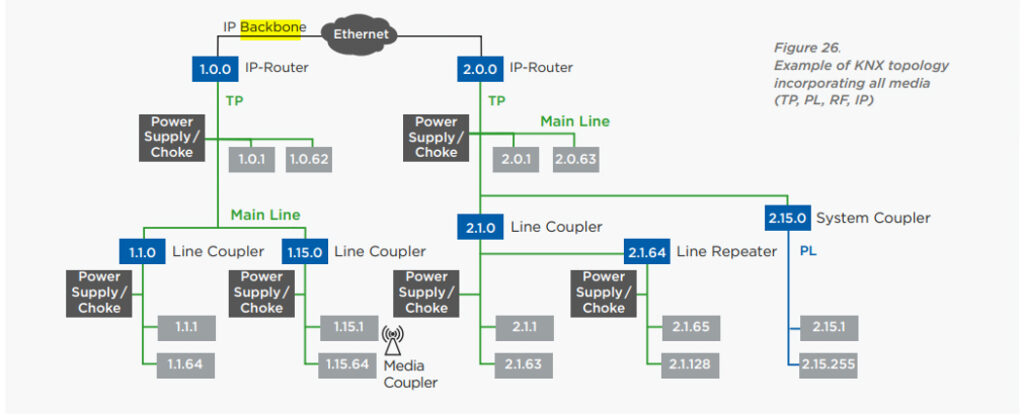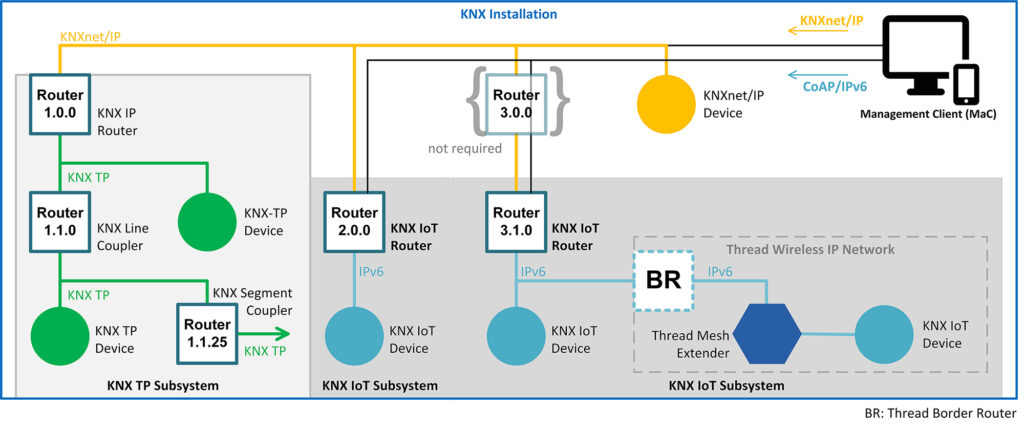
In the fifth of this series of articles on KNX IoT, Bruno Johnson and Wouter van der Beek explain the role of the KNX IoT router.
Digital transformation has been one of the main strategy topics on company board meeting agendas for the last few years. The opportunity to develop digital services from cloud-based applications requires Internet protocol (IPv6) based network connections to edge devices that become the customer interface. Businesses of all shapes and sizes in commercial building automation have been asking for wireless IoT solutions to make this happen, and KNX Association responded by releasing KNX IoT Point API (KNX IoT).
What does the KNX IoT Router do?
The first issue is that there are different transports involved in a KNX system, namely KNX TP (Twisted Pair), KNXnet/IP (IPv4), KNX RF (Radio Frequency) and KNX IoT (IPv6). The KNX IoT router makes the connection between KNX IoT and other KNX transports.
The second issue is that although the KNX IoT subsystem is semantically equivalent to existing KNX systems, there is a need to convert run time communication. This includes the handling of KNX Secure and the KNX IoT security mechanisms. The KNX IoT router handles both issues, by connecting to the existing IPv4 backbone and handling run time mechanisms for seamless interoperability.
Backbone IPv4
A backbone is part of a network which allows for connection between areas that contain areas (or subnets) of devices. The backbone in ETS is the IPv4 backbone. Using the IPv4 backbone, installers can combine products from hundreds of different manufacturers with guaranteed compatibility. Hence to be compatible with the existing installations, KNX IoT devices have their own subnets and connect to the IPv4 backbone. The KNX IoT Router is the device that connects the KNX IoT subnet with other KNX transport media of the system, such as KNX TP. An example of using IPv4 as a backbone is given in the following illustration:

If a KNX installation includes KNX IoT, the IPv4 backbone can also be used to transport the KNX IoT IPv6 message. This is possible because a network can transport IPv4 and IPv6 simultaneously.

KNX IoT router
KNX routers are system components that convert KNX messages between KNX media. The KNX IoT router does this between KNXnet/IP and KNX IoT. The advantage of this approach is that is uses the existing KNX specifications and existing devices on the KNXnet/IP side. Hence the KNX IoT router only has to additionally specify how to convert between KNXnet/IP and KNX IoT. Although the KNX IoT router is a device, the main function is to convert incoming messages from KNXnet/IP to KNX IoT and the incoming messages from KNX IoT to KNXnet/IP. This is depicted in the following figure:

Without extra information one can’t convert data from the net/IP side, since the net/IP side only receives bits which are known, without context. This is overcome by supplying more information by the Management Client (MaC) to the KNX IoT router. There is a new table that contains the following information (per entry):
- Group Address (as a list).
- Data Type, the major number as defined in Datapoint Types, e.g., specifying Boolean, integer, float, etc.
- Security for the group message for KNX Secure (e.g. the KNXnet/IP side).
- Indication if authentication is applied.
- Indication if confidentially is applied.
Additional information to listen to the IPv4 communication is handled with a new functional block net/IP. The net/IP functional block contains the settings for:
- Which multicast address should be used.
- The IPv4 backbone key.
- Time to Live (TTL), e.g. how many routes a multicast message may pass until discarded.
- The IPv4 routing latency tolerance.
- The IPv4 sync latency fraction. This information means that a client has all the necessary information to send and receive net/IP S-mode messages.
The security and sending on the KNX IoT side are handled through the existing KNX IoT tables, as follows:
- The Auth/at Table to register the group keys.
- The Recipient Table, e.g. which info to use for the outgoing communication to the KNX IoT side.
- The Publisher Table, e.g. which info to use to listen to the incoming KNX IoT communication.
- The Group Object Table, indicating which groups are used for sending and receiving.
Summary
By using a KNX IoT router, KNX IoT is completely interoperable with existing KNX infrastructure. Indeed a KNX IoT router can work with existing net/IP routers since it specifies the additional configuration parameters via KNX IoT. This means that a heterogeneous installation can run simultaneously over the same (IT) network, be it wired (Ethernet/PoE) or wireless (Thread / Wi-Fi / cellular), as well as existing KNX transport media. It also means that KNX tools, such as ETS 6, can configure all KNX infrastructure to interoperate, regardless of the transport medium.
Bruno Johnson and Wouter van der Beek are the CEO and COO respectively of Cascoda Limited. Cascoda is a communications company that manufactures secure IoT semiconductor radios and modules, and leads the development of secure IoT communications standards for smart building and smart city. Its products solve range, reliability, security, power and scalability issues for industrial and commercial IoT through patented innovations and the latest most secure standards, all integrated into inexpensive ultra-low power IoT modules.












